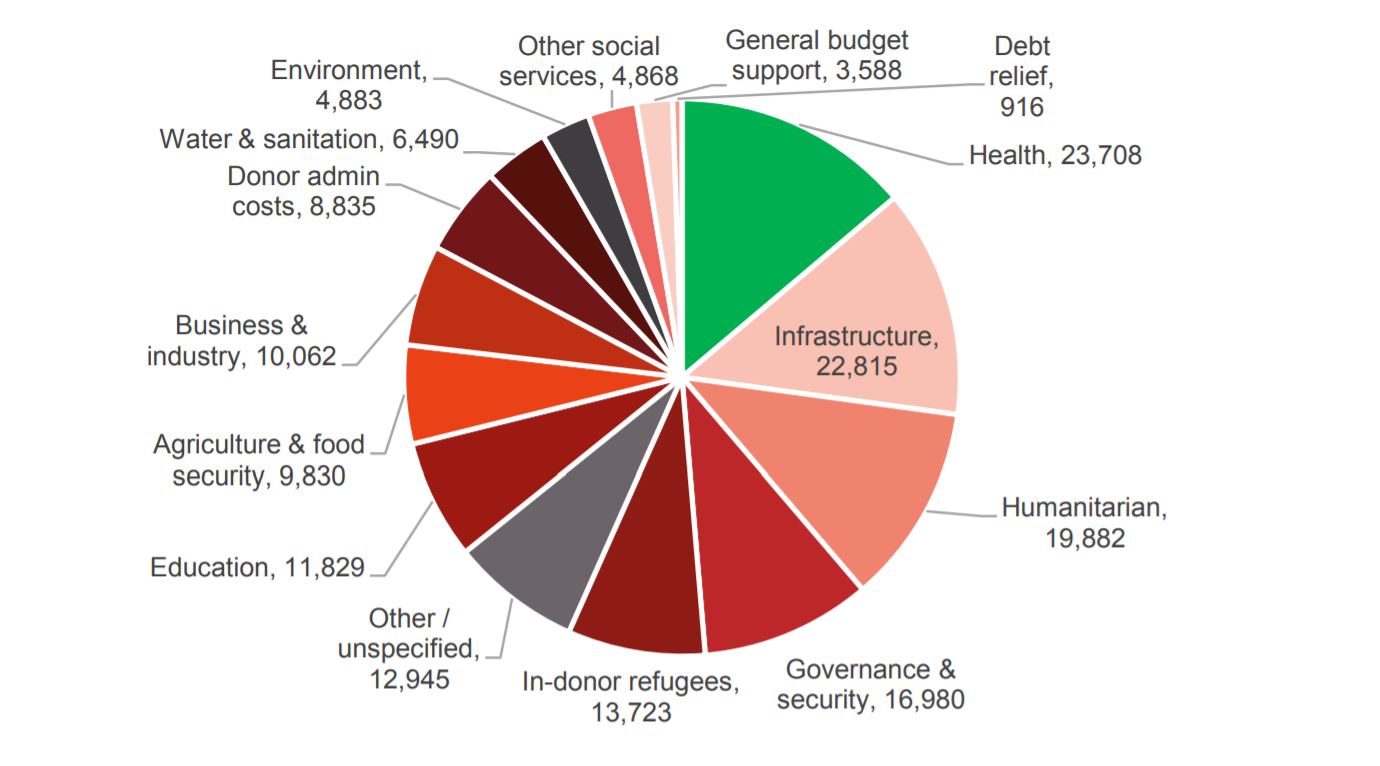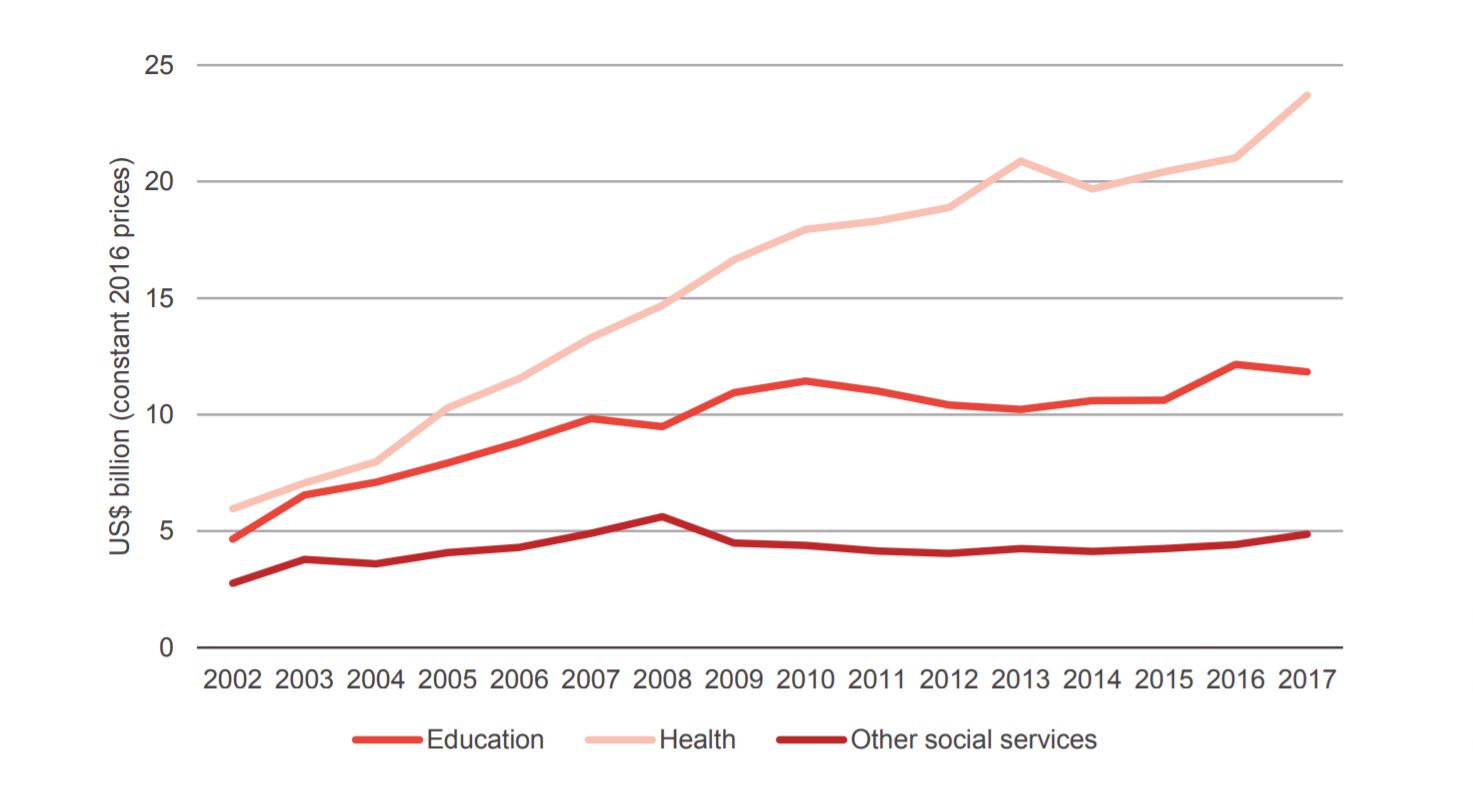In October 2018 Development Initiatives (DI) launched the
third Investments to End Poverty report
, which highlighted a number of challenges with the way that resources are currently allocated across developing countries. Chief among these is the fact that the places and people most at risk of being left behind have access to the fewest resources, and that continuing with business as usual will not improve this scenario. The gap between the poorest people and the rest is growing – in income, in access to resources, in opportunity – and looks set to continue to widen. This, the report shows, leaves a critical role for aid to play in directly targeting poverty eradication. However, concerning trends in the way official development assistance (ODA) is allocated threaten to prevent it from doing so effectively.
The OECD DAC’s release of final 2017 ODA data confirms the findings of Investments to End Poverty 2018, as it shows that these worrying trends (largely) continue. It further underlines the urgency with which action needs to be taken to change trajectory if we are to end poverty by 2030 and leave no one behind. Achieving the Sustainable Development Goals (SDGs) is possible and
there is scope for optimism
. However, much more needs to be done to both increase ODA levels (e.g. only five donors achieved the 0.7% target in 2017, down from six in 2016) and better target ODA to the places and sectors that need it most. For example, similarly to 2016, only a small proportion of ODA reached the countries most at risk of being left behind and no substantial change was recorded in allocations to health and social protection while education saw a small, real terms decrease.
At the High-level Political Forum in 2019, as we review progress on achieving the ambitious Agenda 2030, there is an opportunity for all actors in the development community to take action to change this trajectory so that no one is left behind. DI remains committed to being an active partner in this debate, and continuing the work needed to ensure that the world achieves the SDGs, providing evidence-led research and analysis to inform better and more effective decisions about how scarce development resources can be used most effectively (on questions ranging from
what countries are at most risk of being left behind
to what approaches donors can take to leverage additional
domestic
and private sector resources for poverty eradication).
-
Total net ODA fell in 2017 for the first time in five years
Figure 1

Source: OECD DAC
-
Net ODA fell by US$213 million – the first fall in real terms since 2012.
-
ODA as a percentage of donors’ gross national income (GNI) fell from 0.32% in 2016 to 0.31%.
-
Debt relief fell by approximately US$1.8 billion, following a large debt write-off by Spain in 2016.
-
In-donor refugee costs fell from an all-time high of almost US$16 billion in 2016 but remain at record high levels at over US$13.5 billion.
Table 1: Large rises in ODA from France and Japan were offset by falls elsewhere

Source: OECD DAC
Notes: Table shows top 10 bilateral donors in 2017.
-
ODA as a percentage of GNI fell in 21 out of 29 DAC members in 2017
Figure 2

Source: OECD DAC
-
Five donors achieved the 0.7% ODA-GNI target in 2017, down from six in 2016.
-
Sweden is the most generous donor on this measure at 1.02% of GNI.
-
The percentage of French ODA-GNI rose from 0.38% to 0.43% following a commitment to spend 0.55% by 2022.
-
The proportion of ODA given as core multilateral funding has remained steady
Figure 3

Source: OECD DAC
-
Core multilateral funding accounted for 28% of total net ODA in 2017 – this proportion has remained consistent for the last decade.
-
The US gives a much lower proportion of its ODA in the form of core multilateral funding than other DAC donors. In 2017, multilateral ODA from the US fell by US$1 billion, accounting for just 14% of ODA (down from 17% in 2016).
-
The proportion of ODA not leaving donor countries continues to be high
Figure 4

Source: OECD DAC
-
The amount of ODA actually transferred to countries continues at lower levels than 2013 – 65% compared to 69%.
-
Conversely, ODA that is not transferred and that stays in the donor country continues at high levels, driven in large part by the record high levels of in-donor spending on refugee costs.
-
Eight of the top ten recipients of ODA in 2016 are also top 10 recipients in 2017
Figure 5

Source: OECD DAC
-
Several countries saw significant increases in ODA including Bangladesh, Nigeria, Yemen and Somalia, all driven at least partly by increases in humanitarian assistance.
-
Countries with large decreases included India (which remains the 5th largest recipient), Pakistan, Kenya and Vietnam.
-
From 2016 to 2017, Ethiopia remained the largest recipient of ODA. Bangladesh joined the top 5, moving up 7 places from 2016 to 2017. It displaced Afghanistan as the second largest recipient, with the latter ranked the third largest in 2017.
-
Following minimal growth in recent years, ODA to countries at risk of being left behind grew 12% in 2017, whilst ODA to LDCs and fragile states grew by 11% and 9% respectively
Figure 6

Source: OECD DAC
Note: Data does not include imputed multilateral calculations.
-
Since the debt relief spike of the mid 2000s, ODA to three key groups of countries – fragile states, least-developed countries (LDCs) and countries being left behind – has largely stagnated. However, the 2017 data suggests there is potential cause for cautious optimism if the slight, short-term upward trend continues and action is taken to accelerate it.
-
Some countries at greatest risk of being left behind (for example, Yemen, Syria, Bangladesh and Nigeria) did see significant increases into 2017. However, this has been particularly driven by increases in humanitarian aid.
-
The amount of ODA going to LDCs increased from 2016–2017 – a similar trend can be seen in ODA to fragile states and countries most at risk of being left behind.
-
However, total ODA to LDCs and countries at risk of being left behind continues to represent a relatively small proportion of total ODA at US$49 billion and US$35 billion respectively.
-
Growth in the use of loans continues to outpace grants, even in countries considered to be at risk of or in debt distress
Figure 7

Source: OECD DAC
-
Loans have risen steadily since 2007 and now account for more than a quarter (26%) of gross ODA.
-
Disbursements of grants actually fell by US$500 million in 2017 whilst loans grew by an additional US$5 billion. This pattern was reflected in both bilateral and multilateral ODA.
-
ODA to health is larger than any other single sector… but ODA to other key human capital related sectors has lagged behind
Figure 8


-
Health has been the largest single recipient sector for ODA in every year since 2010.
-
Health, infrastructure, humanitarian aid, and governance, peace and security accounted for a combined 49% of ODA in 2017.
-
Funding for health is boosted by high levels of funding to HIV/AIDS. These diseases account for 32% of ODA spent on health. This focus on HIV/AIDS is mainly due to the US which spends 64% of its health ODA on HIV/AIDS.
-
Other key human capital-related sectors have seen much slower growth in ODA, with spending on education and other social services largely stagnating in recent years.
-
Education, a key sector for human capital development, fell in real terms between 2016 and 2017 by US$325 million.









